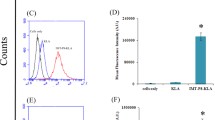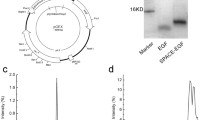Abstract
Effective delivery of therapeutic agents is the most challenging hurdle in the use of RNA interference for research and in the clinic. Here, we assessed whether a short synthetic peptide, ACSSSPSKHCG (TD-1), could be transported through rat footpad (follicle-free) skin and efficiently deliver small interfering RNA (siRNA) to knock down a target gene. Fluorescence microscopy revealed that topical co-administration of FITC-labeled TD-1 and FAM-labeled siRNA distributed uniformly from the epidermis to the subcutaneous tissue of rat footpad skin. Transmission electron microscopy revealed the absence of cell–cell junctions and enlarged spaces between epithelial cells in the TD-1-treated footpad skin. TD-1 delivery of anti-GAPDH siRNA significantly reduced the level of GAPDH in 72 h. TD-1 can create a transient opening in non-follicle rat skin for delivery of siRNA and reveal a novel mechanism of transdermal delivery of TD-1 and siRNA into the epidermis for gene knockdown. The system might have potential for siRNA delivery in skin for drug therapy.




Similar content being viewed by others
Abbreviations
- RNAi:
-
RNA interference
- siRNAs:
-
Small interfering RNAs
- FITC:
-
Fluorescein isothiocyanate
- HPLC:
-
High-performance liquid chromatography
- NC:
-
Negative control
- TEM:
-
Transmission electron microscopy
- FAM:
-
Carboxyfluorescein
- GAPDH:
-
Glyceraldehyde-3-phosphate dehydrogenase
References
Barry BW (2001) Is transdermal drug delivery research still important today? Drug Discov Today 6:967–971
Chen Y, Shen Y, Guo X et al (2006) Transdermal protein delivery by a coadministered peptide identified via phage display. Nat Biotechnol 24:455–460
Fattal E, Bochot A (2008) State of the art and perspectives for the delivery of antisense oligonucleotides and siRNA by polymeric nanocarriers. Int J Pharm 364:237–248
Fougerolles A, Vornlocher HP, Maraganore J et al (2007) Interfering with disease: a progress report on siRNA-based therapeutics. Nat Rev Drug Discov 6:443–453
Han SE, Kang H, Shim GY et al (2008) Novel cationic cholesterol derivative-based liposomes for serum-enhanced delivery of siRNA. Int J Pharm 353:260–269
Inoue T, Sugimoto M, Sakurai T et al (2007) Modulation of scratching behavior by silencing an endogenous cyclooxygenase-1 gene in the skin through the administration of siRNA. J Gene Med 9:994–1001
Kigasawa K, Kajimoto K, Hama S et al (2010) Noninvasive delivery of siRNA into the epidermis by iontophoresis using an atopic dermatitis-like model rat. Int J Pharm 383:157–160
Kigasawa K, Kajimoto K, Nakamura T et al (2011) Noninvasive and efficient transdermal delivery of CpG-oligodeoxynucleotide for cancer immunotherapy. J Control Release 150:256–265
Pardridge WM (2007) shRNA and siRNA delivery to the brain. Adv Drug Deliv Rev 59:141–152
Sanders N, Rudolph C, Braeckmans K et al (2009) Extracellular barriers in respiratory gene therapy. Adv Drug Deliv Rev 61:115–127
Tezel A, Dokka S, Kelly S et al (2004) Topical delivery of anti-sense oligonucleotides using low-frequency sonophoresis. Pharm Res 21:2219–2225
Wang Q, Ilves H, Chu P et al (2007) Delivery and inhibition of reporter genes by small interfering RNAs in a mouse skin model. J Invest Dermatol 127:2577–2584
Xie FY, Woodle MC, Lu PY (2006) Harnessing in vivo siRNA delivery for drug discovery and therapeutic development. Drug Discov Today 11:67–73
Acknowledgments
This research was supported by the National Natural Science Foundation of China (No. 30801196, No. 81071577) and the Natural Science Foundation of Guangdong Province (No. 9151008901000141).
Author information
Authors and Affiliations
Corresponding author
Additional information
C-M. Lin and K. Huang contributed equally to this work.
Rights and permissions
About this article
Cite this article
Lin, CM., Huang, K., Zeng, Y. et al. A simple, noninvasive and efficient method for transdermal delivery of siRNA. Arch Dermatol Res 304, 139–144 (2012). https://doi.org/10.1007/s00403-011-1181-5
Received:
Revised:
Accepted:
Published:
Issue Date:
DOI: https://doi.org/10.1007/s00403-011-1181-5




